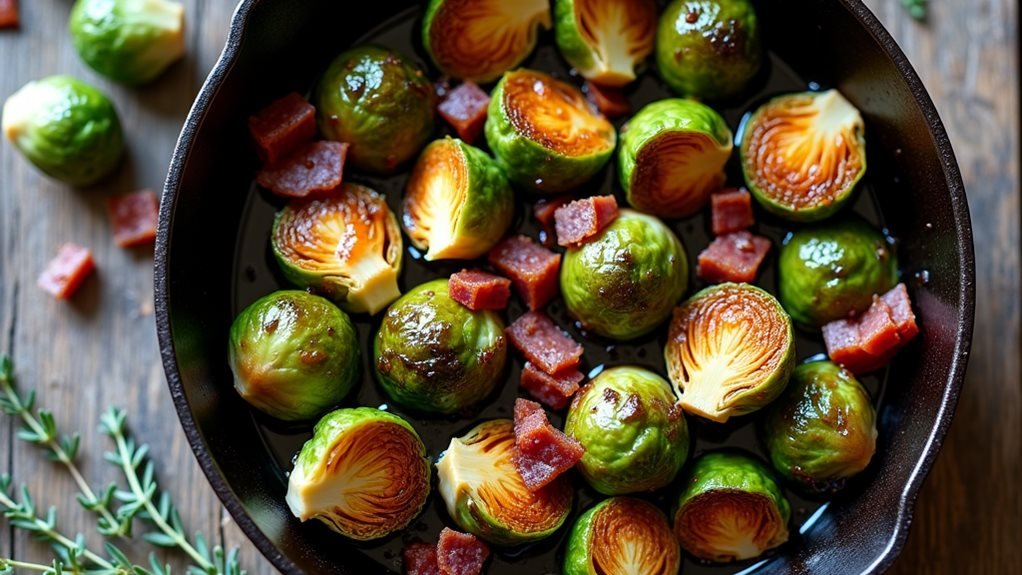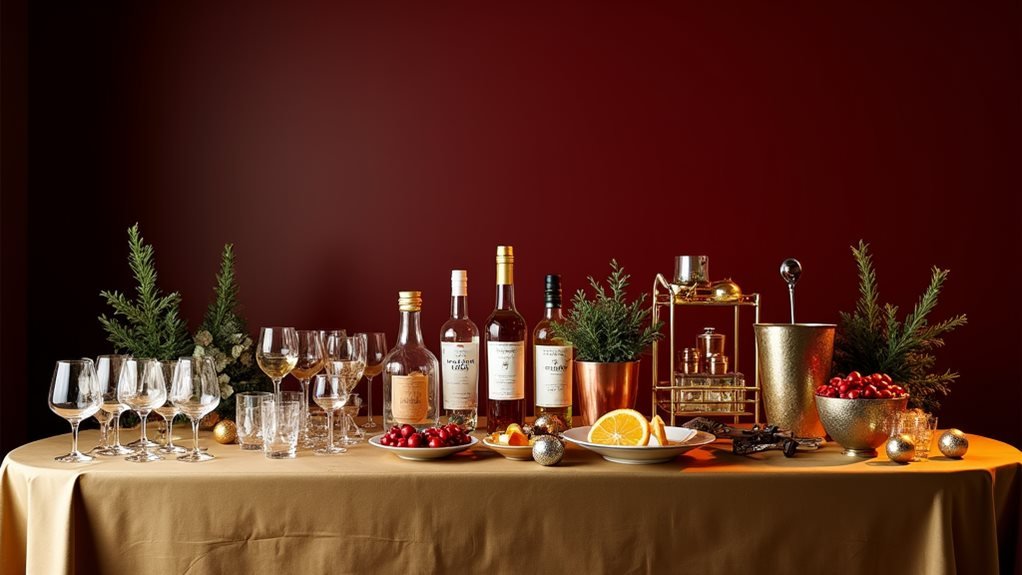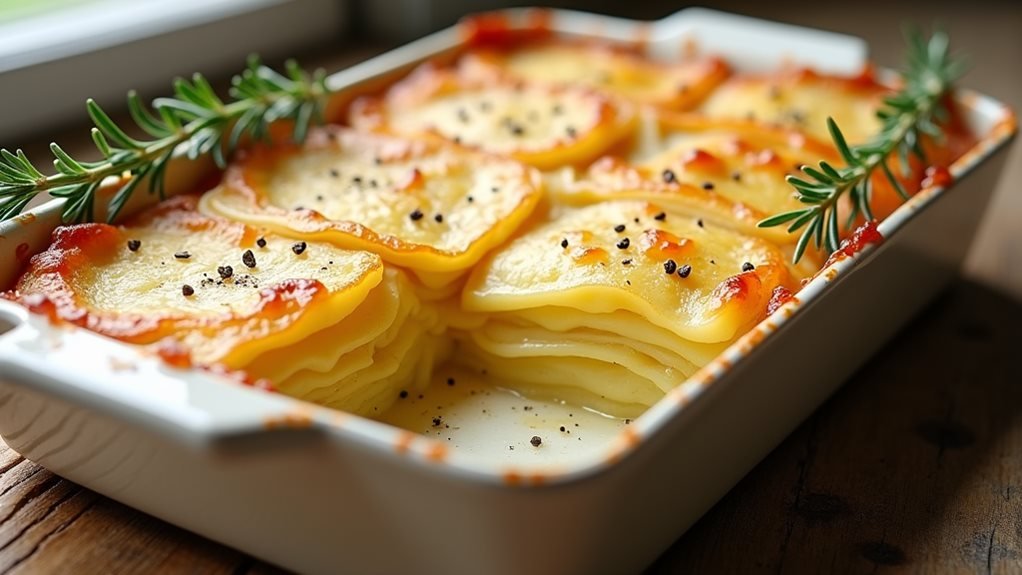You’ve probably encountered Brussels sprouts cooked the traditional way—boiled until soft and unpleasant. But this revamped rendition, inspired by Gordon Ramsay’s distinctive flair, turns these modest vegetables into an elegant dish suitable for any upscale restaurant menu. By blending crispy pancetta, impeccably caramelized sprouts, and a luxurious balsamic reduction, you’ll unearth a cooking approach that converts even the staunchest Brussels sprouts doubters. The key lies not only in the components but in particular methods that enhance this side dish from average to exceptional.
Recipe Insights
- Caramelizing Brussels sprouts with pancetta creates a perfect balance of sweet and savory flavors reminiscent of Ramsay’s signature style.
- Quality balsamic reduction transforms ordinary sprouts into an elegant side dish with a rich, glossy finish.
- Crispy pancetta adds a gourmet touch while providing a textural contrast to the tender, caramelized sprouts.
- Pre-warming serving platters and garnishing with Parmesan elevate presentation to restaurant-quality standards.
- Precise timing of garlic addition and careful balsamic reduction prevent burning while developing complex flavors.
History
Dating back to ancient Rome, Brussels sprouts halved from their primitive cabbage ancestors into the compact, leafy vegetables we know today. Their first documented cultivation was in Belgium during the 13th century, where they thrived in the cool climate around Brussels, hence their name. These miniature cabbages quickly spread throughout Europe, becoming a staple in many households by the 16th century.
You’ve probably noticed that Brussels sprouts have experienced a remarkable transformation in recent years. They have gone from being one of America’s most despised vegetables to a trendy restaurant favorite. This shift can be traced to the 1990s when farmers developed sweeter varieties with fewer bitter compounds.
You’ll uncover that modern cultivation techniques have reduced the sprouts’ glucosinolate content, the compound responsible for their infamous bitter taste and sulfurous smell when overcooked. Today’s Brussels sprouts are particularly sweeter and more versatile, leading to their renaissance in contemporary cuisine. They’ve become a canvas for creative cooking methods, from roasting to shaving raw into salads, proving that proper preparation can transform even the most maligned vegetables into sought-after delicacies. Much like ricotta gnocchi varieties, Brussels sprouts have evolved to offer lighter, more delicate flavors that pair beautifully with contemporary dishes.
Recipe
Brussels sprouts take on a whole new identity in this elegant preparation, which combines crispy pancetta, caramelized vegetables, and a rich balsamic glaze. The natural sweetness of properly cooked Brussels sprouts shines through, while the complementary ingredients create layers of flavor that will convert even the most adamant sprout skeptics.
This recipe transforms the often-maligned vegetable into a sophisticated side dish that’s just as suitable on a holiday table as it is for a weeknight dinner. The combination of salty pancetta and sweet balsamic vinegar creates a perfect balance, while proper cooking techniques guarantee the sprouts maintain their bright color and pleasantly firm texture.
This side dish would feel right at home alongside Ramsay’s Beef Wellington, the signature dish that helped establish his culinary legacy.
- 2 pounds Brussels sprouts, halved
- 6 ounces diced pancetta
- 3 tablespoons extra virgin olive oil
- 2 cloves garlic, thinly sliced
- 1/4 cup aged balsamic vinegar
Heat olive oil in a large skillet over medium-high heat. Cook pancetta until crispy, then remove and set aside. Place Brussels sprouts cut-side down in the same pan and cook undisturbed for 5 minutes until golden brown. Add sliced garlic and continue cooking for 3-4 minutes, stirring occasionally. Return the pancetta to the pan, add balsamic vinegar, and cook for 2 minutes until the vinegar reduces and coats the sprouts evenly.
For best results, choose Brussels sprouts of similar size to ensure even cooking, and avoid washing them just before cooking, as excess moisture will prevent proper caramelization. If your pan isn’t large enough to accommodate all the sprouts without overcrowding, cook them in batches – overcrowding will cause them to steam rather than caramelize. The finished dish can be prepared up to 2 hours ahead and reheated gently before serving.
Cooking Steps
You’ll start by heating your pan with olive oil and cooking the diced pancetta until it’s perfectly crispy, then set it aside.
Next, cook your halved Brussels sprouts in the same pan, letting them caramelize undisturbed before adding the sliced garlic and stirring occasionally.
Ultimately, you’ll return the pancetta to the pan and add your balsamic vinegar, allowing it to reduce into a glossy sauce that coats everything beautifully.
Step 1. Heat Pan With Oil First
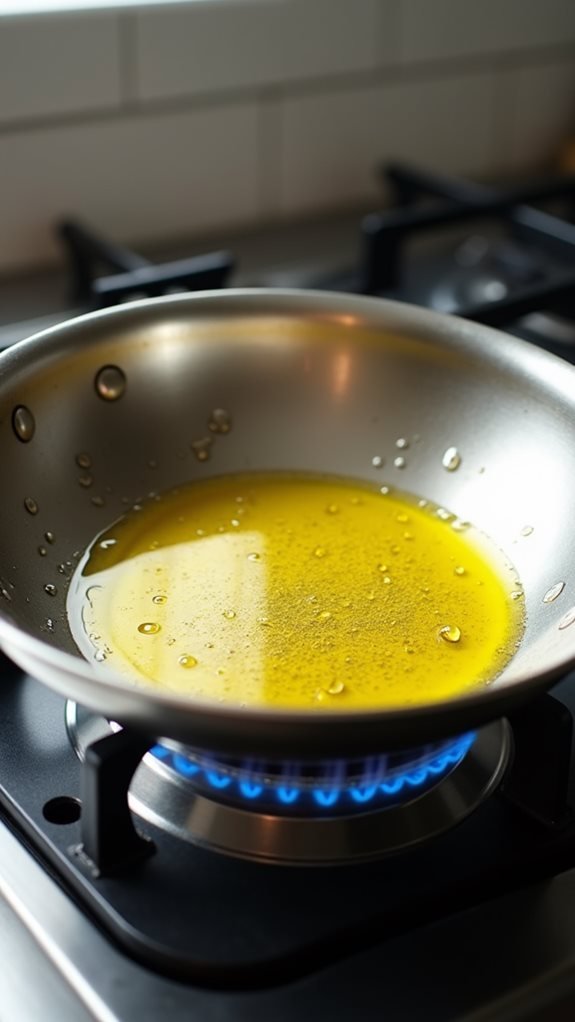
To begin this delicious transformation, heat a large skillet over medium-high heat and add 3 tablespoons of extra virgin olive oil. Let the oil heat up until it shimmers but not smokes, which typically takes about 1-2 minutes. This initial step is vital for achieving the perfect sear on your Brussels sprouts later.
While you wait for the oil to reach the right temperature, you can test its readiness by hovering your hand about 6 inches above the pan’s surface—you should feel steady, radiating heat. If the oil starts to smoke, you’ll need to remove the pan from the heat, let it cool slightly, and start again. Remember, properly heated oil will create that gorgeous golden-brown crust on your sprouts without burning them.
Don’t rush this foundational step, as the oil’s temperature will directly impact how your pancetta renders and how well your Brussels sprouts caramelize.
When the oil is ready, you’ll notice small ripples across its surface, signaling that it’s time to add the pancetta and begin the next phase of cooking.
Step 2. Cook Pancetta Until Crispy

Once your oil reaches the ideal temperature, add the diced pancetta to the pan, spreading it evenly across the surface. You’ll want to maintain medium-high heat as the pancetta begins to release its fat, creating a foundation of flavor that’ll enrich your Brussels sprouts. Stir occasionally to ensure uniform browning, and watch for the pieces to become golden and crispy gradually.
As the pancetta cooks, you’ll notice it starting to shrink and curl slightly – this is precisely what you’re aiming for. The process should take about 4-5 minutes, during which the pieces will transform from soft, pink cubes to crispy, golden-brown morsels. Don’t rush this step; proper rendering is vital for achieving the perfect texture and releasing those rich, savory flavors into the oil.
Once your pancetta reaches a uniformly crispy state, remove it from the pan using a slotted spoon, leaving the flavorful fat behind. Set the crispy bits aside on a paper towel-lined plate – you’ll be adding them back to the dish later to maintain their delightful crunch.
Step 3. Add Halved Brussels Sprouts
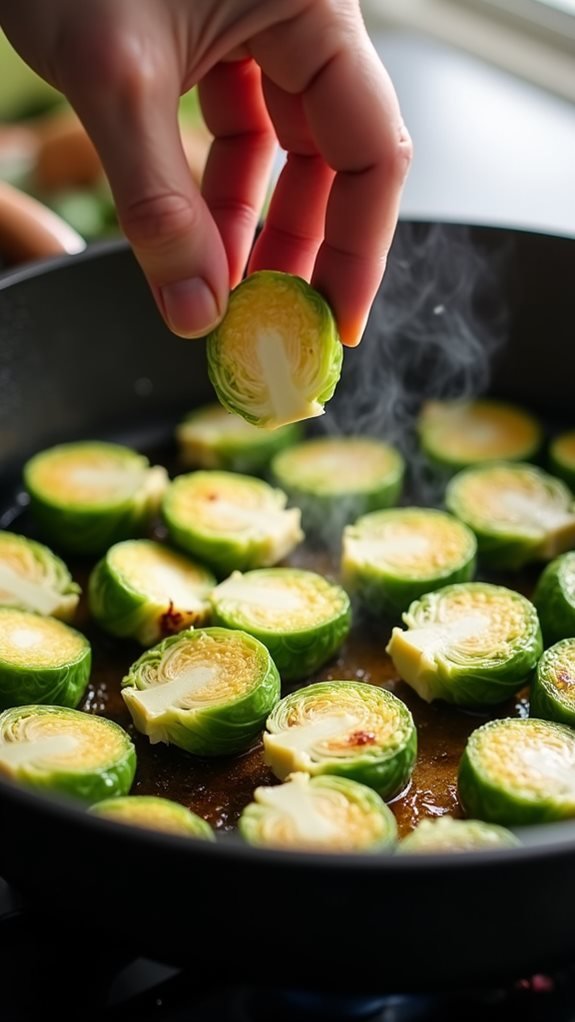
After removing the pancetta, carefully place your halved Brussels sprouts into the hot pan, positioning them cut-side down in a single layer. You’ll want to hear that satisfying sizzle as they make contact with the hot surface, which indicates you’re on your way to achieving perfect caramelization. Don’t disturb them for the initial 5 minutes – this patience is vital for developing that golden-brown crust.
If you can’t fit all the sprouts cut-side down at once, it’s better to work in batches than to overcrowd the pan.
You’ll know they’re ready to stir when the bottoms have turned a deep golden brown, and the tops are starting to brighten to a vibrant green. At this point, you can give them a gentle toss to guarantee even cooking.
Keep a close eye on the heat level – you’re looking for steady caramelization, not charring. If your pan starts to smoke, reduce the heat slightly.
The sprouts should maintain their bright color while developing those perfectly crispy edges that will make your dish irresistible.
Step 4. Add Garlic and Stir
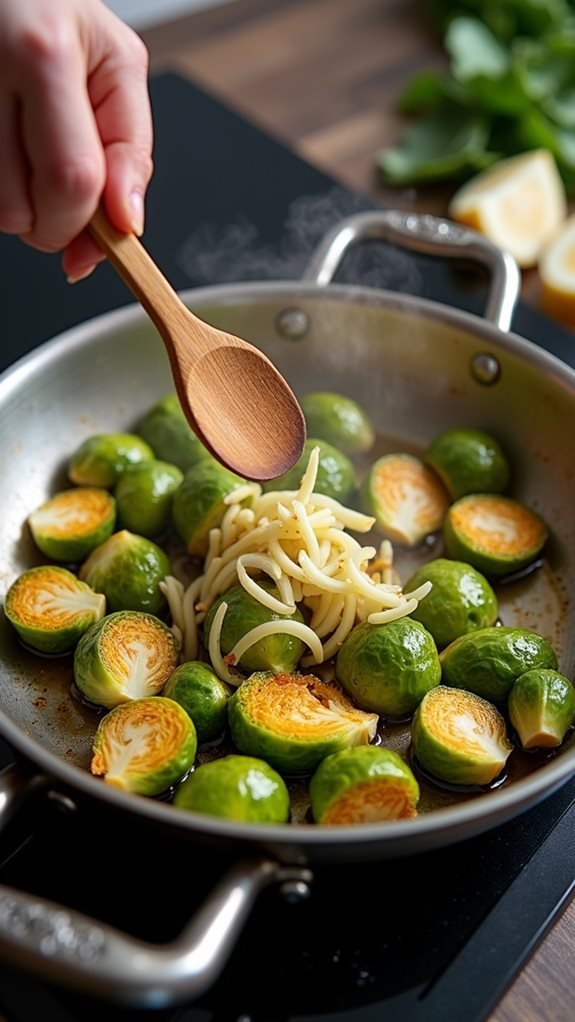
The sizzling sprouts signal the perfect moment to add your thinly sliced garlic to the pan. Distribute the garlic pieces evenly among the sprouts, ensuring they don’t cluster together, which could lead to burning. As the garlic releases its aromatic oils, you’ll notice an enticing fragrance filling your kitchen.
For the next 3-4 minutes, stir the sprouts occasionally, allowing them to continue caramelizing while preventing the garlic from becoming too dark. You’re looking for the garlic to turn golden brown, not bitter and burnt. If you notice the garlic cooking too quickly, lower your heat slightly to maintain control over the process.
During this phase, the Brussels sprouts will develop deeper caramelization on multiple sides. They should maintain their bright green color while showing beautiful golden-brown patches. Don’t be tempted to rush this step—proper caramelization is essential for developing the complex flavors that will make your dish stand out.
The sprouts should be tender when pierced with a fork but still retain their structure.
Step 5. Add Balsamic and Reduce Sauce
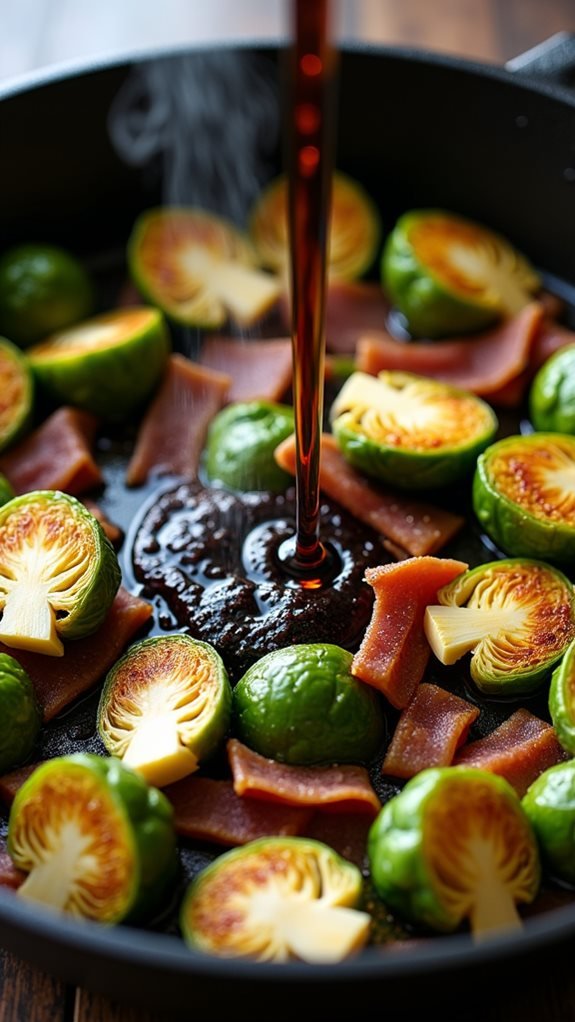
Now that your garlic and sprouts have achieved the perfect caramelization, it’s time to bring back the reserved pancetta and introduce the balsamic vinegar to create a luxurious glaze. Return the crispy pancetta to the pan, distributing it evenly among the sprouts to ensure that each bite delivers the perfect combination of flavors.
Add the quarter cup of aged balsamic vinegar, allowing it to sizzle as it hits the hot pan. You’ll notice the vinegar will immediately start to reduce and thicken. Keep a close eye on the process, as you’ll want to achieve a syrupy consistency that coats the back of a spoon. This typically takes about two minutes, but you’ll need to stir continuously to prevent the vinegar from burning.
If you notice the balsamic reducing too quickly or starting to burn, don’t panic – remove the pan from heat and add a small splash of water to halt the cooking process.
The finished sauce should cling to the sprouts, creating a glossy finish that makes each piece glisten with an appetizing sheen.
Common Questions About This Recipe
Since making this Brussels sprouts dish involves several crucial steps and ingredients, home cooks frequently ask about potential substitutions and timing.
You’ll find that bacon can replace pancetta, though the flavor will be smokier and slightly less intricate. If you’re creating a vegetarian version, try substituting mushrooms sautéed in olive oil to maintain that savory depth.
Another common question concerns the quality of balsamic vinegar. While you don’t need the most expensive aged variety, avoid the lowest-priced options, as they won’t properly reduce into that signature syrupy consistency. If your balsamic vinegar isn’t reducing as expected, you’re likely using a lower-quality product with added sugars and preservatives.
For timing concerns, you can prep the sprouts up to a day ahead by cleaning and halving them and storing them in an airtight container in the refrigerator. You’ll achieve the best results when cooking the dish just before serving. Still, if needed, you can reheat it gently over medium-low heat, adding a small splash of water to prevent sticking and maintain the sauce’s consistency.
Final Thoughts and Serving Ideas
Mastering this Brussels sprouts dish opens up countless serving possibilities for your table. As a sophisticated holiday side dish, it pairs beautifully with roasted turkey, glazed ham, or prime rib. The combination of crispy pancetta and balsamic reduction heightens these sprouts beyond traditional vegetable fare, making them worthy of your most special occasions.
For an elegant presentation, serve the sprouts on a pre-warmed platter and drizzle any remaining balsamic reduction over the top.
You can garnish with extra crispy pancetta bits and, if desired, add a sprinkle of freshly grated Parmesan cheese or toasted pine nuts for additional texture.
Don’t hesitate to double the recipe for larger gatherings. Remember to cook in batches to maintain proper caramelization.
Consider serving these Brussels sprouts alongside other complementary sides like roasted root vegetables or creamy mashed potatoes.
The dish holds up well at room temperature, making it ideal for buffet-style service.
You can also incorporate leftovers into grain bowls or warm salads for a delicious next-day meal.
